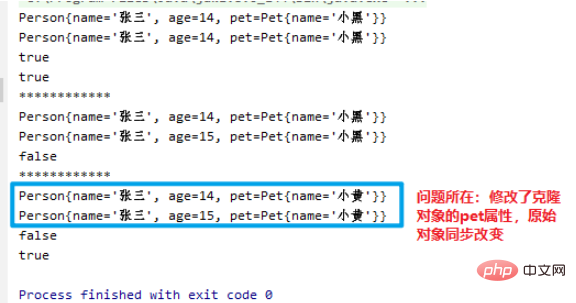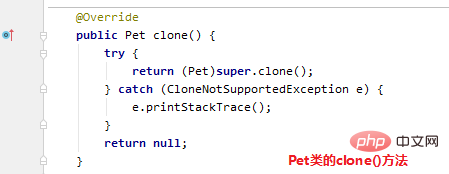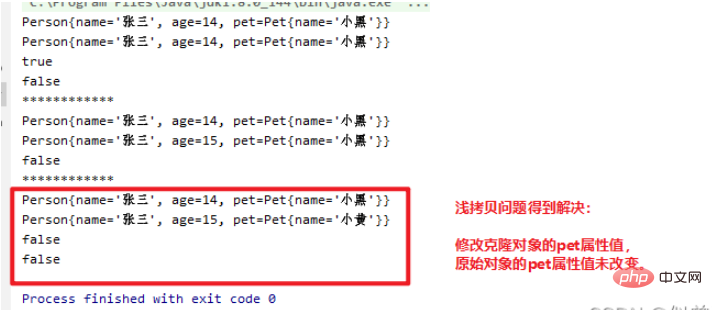Deep copy and shallow copy methods of Java Cloneable interface
Cloneable interface source code
Cloneable interface:
The class that implements this interface--can be It is inferred that the clone() method of java.lang.Object can be legally called - to implement class instance: property-to-property copying.
If a class does not implement the Cloneable interface, then when the clone() method is called, a CloneNotSupportedException exception will be thrown.
Generally, subclasses that implement the Cloneable interface should override the clone() method with public access permissions (although the clone method in the java.Object class is of protected type)
It should be realized that the Cloneable interface does not contain the clone() method. Therefore, if you just implement the Cloneable interface, you will not be able to clone the object normally.
[Reason: Even if it is called reflectively There is no guarantee that the cloning method will be successful] - My personal understanding is: It is caused by whether to override the Clone() method, or by the existence of the "shallow copy and deep copy" problem.
class Pet implements Cloneable{
//properties
private String name;
public void setName(String name) {
this.name = name;
}
public String getName() {
return name;
}
public Pet() {
}
public Pet(String name) {
this.name = name;
}
@Override
public String toString() {
return "Pet{" +
"name='" + name + '\'' +
'}';
}
@Override
public boolean equals(Object o) {
if (this == o) return true;
if (o == null || getClass() != o.getClass()) return false;
Pet pet = (Pet) o;
return Objects.equals(name, pet.name);
}
@Override
public int hashCode() {
return Objects.hash(name);
}
// @Override
// public Pet clone() {
// try {
// return (Pet)super.clone();
// } catch (CloneNotSupportedException e) {
// e.printStackTrace();
// }
// return null;
// }
}Shallow copy case
Pet class definition
Note: The Pet class implements the Cloneable interface, but does not override the Clone() method (obviously: this The Pet class does not have the ability to clone objects).
class Pet implements Cloneable{
//properties
private String name;
public void setName(String name) {
this.name = name;
}
public String getName() {
return name;
}
public Pet() {
}
public Pet(String name) {
this.name = name;
}
@Override
public String toString() {
return "Pet{" +
"name='" + name + '\'' +
'}';
}
@Override
public boolean equals(Object o) {
if (this == o) return true;
if (o == null || getClass() != o.getClass()) return false;
Pet pet = (Pet) o;
return Objects.equals(name, pet.name);
}
@Override
public int hashCode() {
return Objects.hash(name);
}
// @Override
// public Pet clone() {
// try {
// return (Pet)super.clone();
// } catch (CloneNotSupportedException e) {
// e.printStackTrace();
// }
// return null;
// }
}Person class definition
Note: The Person class implements the Cloneable interface and also overrides the Clone() method. So, does the Person class have the ability to clone objects? (Due to the shallow copy problem, this object cloning capability is considered incomplete and defective).
class Pet implements Cloneable{
//properties
private String name;
public void setName(String name) {
this.name = name;
}
public String getName() {
return name;
}
public Pet() {
}
public Pet(String name) {
this.name = name;
}
@Override
public String toString() {
return "Pet{" +
"name='" + name + '\'' +
'}';
}
@Override
public boolean equals(Object o) {
if (this == o) return true;
if (o == null || getClass() != o.getClass()) return false;
Pet pet = (Pet) o;
return Objects.equals(name, pet.name);
}
@Override
public int hashCode() {
return Objects.hash(name);
}
// @Override
// public Pet clone() {
// try {
// return (Pet)super.clone();
// } catch (CloneNotSupportedException e) {
// e.printStackTrace();
// }
// return null;
// }
}Shallow copy problem-code test
Why is it said that the object cloning ability of the Person class is incomplete and defective at this time? Because at this time, when the clone() method is called through the Person object and the object is cloned, the clone of the value of its member attribute pet (an object of the Pet class) is just a simple copy of the memory address in the heap area.
That is: To put it bluntly, the pet attribute value of the Person object and the cloned object share the same heap area memory. The problem is obvious: when the pet attribute of the cloned object is set, it will obviously affect the pet attribute value of the original Person object.
The code demonstration is as follows:
//methods
public static void main(String[] args) throws CloneNotSupportedException {
testPerson();
}
public static void testPerson() throws CloneNotSupportedException {
Person p=new Person("张三",14,new Pet("小黑"));
System.out.println(p);
Person clone = (Person)p.clone();
System.out.println(clone);
System.out.println(p.equals(clone));
System.out.println(p.getPet()==clone.getPet());
System.out.println("************");
clone.setAge(15);
System.out.println(p);
System.out.println(clone);
System.out.println(p.equals(clone));
System.out.println("************");
clone.getPet().setName("小黄");
System.out.println(p);
System.out.println(clone);
System.out.println(p.equals(clone));
System.out.println(p.getPet()==clone.getPet());
}
Deep copy case
So, how to implement deep copy? The key lies in the commented lines of code in the above case.
Pet class overrides the clone() method

Call Pet’s clone method in Person’s clone() method

Shallow copy problem solving-deep copy code test
The test code remains unchanged, run again:

The above is the detailed content of Deep copy and shallow copy methods of Java Cloneable interface. For more information, please follow other related articles on the PHP Chinese website!

Hot AI Tools

Undresser.AI Undress
AI-powered app for creating realistic nude photos

AI Clothes Remover
Online AI tool for removing clothes from photos.

Undress AI Tool
Undress images for free

Clothoff.io
AI clothes remover

Video Face Swap
Swap faces in any video effortlessly with our completely free AI face swap tool!

Hot Article

Hot Tools

Notepad++7.3.1
Easy-to-use and free code editor

SublimeText3 Chinese version
Chinese version, very easy to use

Zend Studio 13.0.1
Powerful PHP integrated development environment

Dreamweaver CS6
Visual web development tools

SublimeText3 Mac version
God-level code editing software (SublimeText3)

Hot Topics
 Java Spring Interview Questions
Aug 30, 2024 pm 04:29 PM
Java Spring Interview Questions
Aug 30, 2024 pm 04:29 PM
In this article, we have kept the most asked Java Spring Interview Questions with their detailed answers. So that you can crack the interview.
 Break or return from Java 8 stream forEach?
Feb 07, 2025 pm 12:09 PM
Break or return from Java 8 stream forEach?
Feb 07, 2025 pm 12:09 PM
Java 8 introduces the Stream API, providing a powerful and expressive way to process data collections. However, a common question when using Stream is: How to break or return from a forEach operation? Traditional loops allow for early interruption or return, but Stream's forEach method does not directly support this method. This article will explain the reasons and explore alternative methods for implementing premature termination in Stream processing systems. Further reading: Java Stream API improvements Understand Stream forEach The forEach method is a terminal operation that performs one operation on each element in the Stream. Its design intention is
 PHP: A Key Language for Web Development
Apr 13, 2025 am 12:08 AM
PHP: A Key Language for Web Development
Apr 13, 2025 am 12:08 AM
PHP is a scripting language widely used on the server side, especially suitable for web development. 1.PHP can embed HTML, process HTTP requests and responses, and supports a variety of databases. 2.PHP is used to generate dynamic web content, process form data, access databases, etc., with strong community support and open source resources. 3. PHP is an interpreted language, and the execution process includes lexical analysis, grammatical analysis, compilation and execution. 4.PHP can be combined with MySQL for advanced applications such as user registration systems. 5. When debugging PHP, you can use functions such as error_reporting() and var_dump(). 6. Optimize PHP code to use caching mechanisms, optimize database queries and use built-in functions. 7
 PHP vs. Python: Understanding the Differences
Apr 11, 2025 am 12:15 AM
PHP vs. Python: Understanding the Differences
Apr 11, 2025 am 12:15 AM
PHP and Python each have their own advantages, and the choice should be based on project requirements. 1.PHP is suitable for web development, with simple syntax and high execution efficiency. 2. Python is suitable for data science and machine learning, with concise syntax and rich libraries.
 Java Program to Find the Volume of Capsule
Feb 07, 2025 am 11:37 AM
Java Program to Find the Volume of Capsule
Feb 07, 2025 am 11:37 AM
Capsules are three-dimensional geometric figures, composed of a cylinder and a hemisphere at both ends. The volume of the capsule can be calculated by adding the volume of the cylinder and the volume of the hemisphere at both ends. This tutorial will discuss how to calculate the volume of a given capsule in Java using different methods. Capsule volume formula The formula for capsule volume is as follows: Capsule volume = Cylindrical volume Volume Two hemisphere volume in, r: The radius of the hemisphere. h: The height of the cylinder (excluding the hemisphere). Example 1 enter Radius = 5 units Height = 10 units Output Volume = 1570.8 cubic units explain Calculate volume using formula: Volume = π × r2 × h (4
 PHP vs. Other Languages: A Comparison
Apr 13, 2025 am 12:19 AM
PHP vs. Other Languages: A Comparison
Apr 13, 2025 am 12:19 AM
PHP is suitable for web development, especially in rapid development and processing dynamic content, but is not good at data science and enterprise-level applications. Compared with Python, PHP has more advantages in web development, but is not as good as Python in the field of data science; compared with Java, PHP performs worse in enterprise-level applications, but is more flexible in web development; compared with JavaScript, PHP is more concise in back-end development, but is not as good as JavaScript in front-end development.
 PHP vs. Python: Core Features and Functionality
Apr 13, 2025 am 12:16 AM
PHP vs. Python: Core Features and Functionality
Apr 13, 2025 am 12:16 AM
PHP and Python each have their own advantages and are suitable for different scenarios. 1.PHP is suitable for web development and provides built-in web servers and rich function libraries. 2. Python is suitable for data science and machine learning, with concise syntax and a powerful standard library. When choosing, it should be decided based on project requirements.
 Create the Future: Java Programming for Absolute Beginners
Oct 13, 2024 pm 01:32 PM
Create the Future: Java Programming for Absolute Beginners
Oct 13, 2024 pm 01:32 PM
Java is a popular programming language that can be learned by both beginners and experienced developers. This tutorial starts with basic concepts and progresses through advanced topics. After installing the Java Development Kit, you can practice programming by creating a simple "Hello, World!" program. After you understand the code, use the command prompt to compile and run the program, and "Hello, World!" will be output on the console. Learning Java starts your programming journey, and as your mastery deepens, you can create more complex applications.






